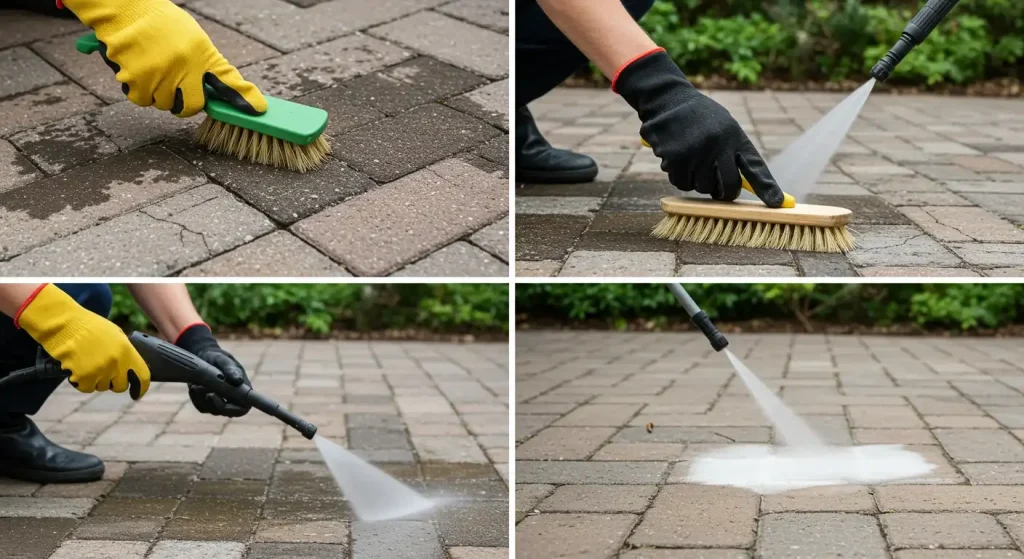Removing old sealer from pavers can seem like a big task, but with the right knowledge and a little patience, it’s something any determined homeowner can handle. Whether your pavers have become cloudy, discolored, or slippery due to aged sealer, giving them a fresh start can greatly improve the look and safety of your outdoor space. Let’s walk through the entire process step-by-step in a clear and approachable way.
Why Remove Old Sealer in the First Place?
Over time, sealers can wear unevenly, trapping dirt, moisture, and even mold beneath the surface. If the old sealer was applied too heavily or without proper cleaning, it may peel or turn white. Sometimes it simply fades and stops doing its job of protecting the pavers. If you want to reseal your pavers properly, removing the old layer is essential. Applying a new sealer over a worn or failing one only leads to further problems down the road.
Type of Sealer on Your Pavers
Before you start the removal process, it helps to know what kind of sealer was originally applied. There are two main types: water-based and solvent-based. Water-based sealers tend to be easier to remove, while solvent-based sealers may require stronger chemicals and a bit more effort.
If you’re unsure, test a small, hidden area with a bit of xylene (a common solvent). Look, the surface becomes sticky, it’s likely a solvent-based sealer. If nothing changes, it may be water-based. Knowing this helps you choose the right method and products for removal.
Start with Surface Preparation
Begin by cleaning the area to remove loose debris, dirt, and grime. Use a broom or blower to clear the surface, and if needed, hose it down to remove surface dust. This step doesn’t remove the sealer, but it ensures you’re working on a clean surface. It also helps the stripper work more effectively.
Apply the Sealer Remover Carefully
Next, you’ll need a quality sealer stripper. Choose one that matches the type of sealer you’re trying to remove. Always read the manufacturer’s instructions carefully. Most strippers are applied generously with a brush, roller, or sprayer and then allowed to sit for some time, usually 15 to 30 minutes.
During this time, the stripper breaks down the old sealer. You’ll start to see it bubble, lift, or soften. Make sure to wear gloves and protective eyewear, as the chemicals can be strong. Also, ensure proper ventilation if you’re working in a partially enclosed space.

Scrub and Pressure Wash for Best Results
Once the stripper has done its job, use a stiff-bristle broom or scrub brush to agitate the surface and loosen the softened sealer. After scrubbing, rinse thoroughly using a pressure washer. The high-pressure water will help blast away the old sealer along with the chemical remover.
Be careful not to hold the pressure washer too close to the pavers. Aim for a medium pressure setting to avoid damaging the surface. Move the wand steadily and evenly to clean the surface without leaving streaks.
Repeat the Process If Needed
In some cases, especially with thick or multiple layers of old sealer, one round of stripping may not be enough. If you still notice glossy or sticky patches, you may need to repeat the stripping process on those areas. This is normal and part of ensuring a clean slate before resealing.
Let the Pavers Dry Completely
After cleaning, allow the pavers to dry for at least 24 to 48 hours before doing anything else. This step is crucial. Any leftover moisture can interfere with the new sealer application. A dry surface ensures that the new sealer will bond properly and evenly.
Consider Resealing Afterward
Once the old sealer is completely gone and the surface is dry, you have the option to leave the pavers natural or apply a new coat of fresh sealer. If you choose to reseal, make sure to use a high-quality product and follow the instructions carefully. Sealing helps protect your pavers from stains, weather, and fading, and gives them a clean, enhanced finish.
Conclusion
Removing old sealer from pavers is a process that requires time, care, and the right materials. But it’s a worthwhile effort that restores the natural beauty of your hardscape and sets the stage for a longer-lasting, better-looking seal in the future. With a bit of preparation and patience, you can take control of the project and give your outdoor space a fresh new start.
